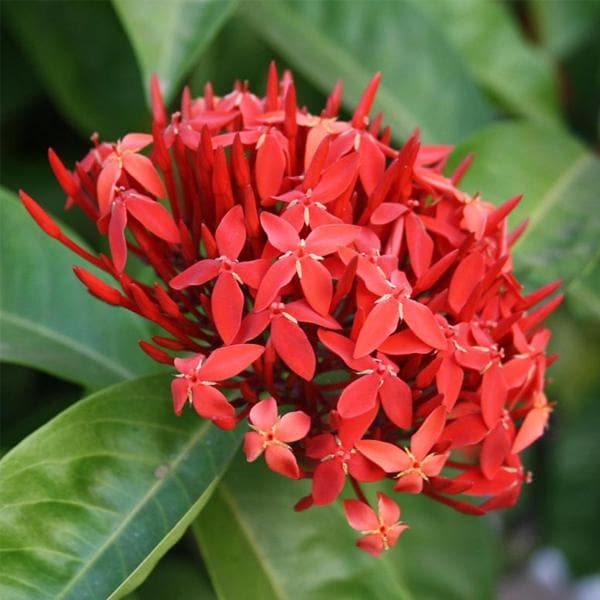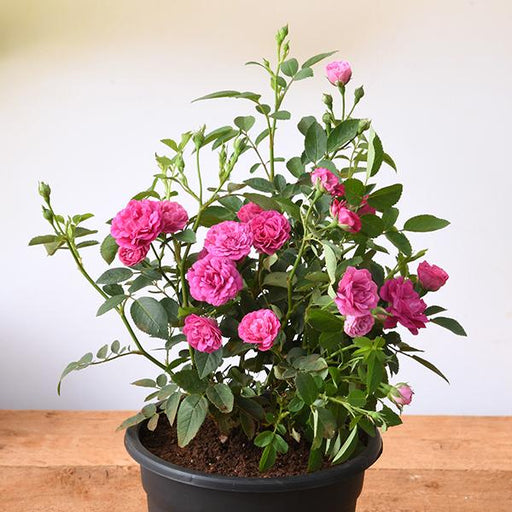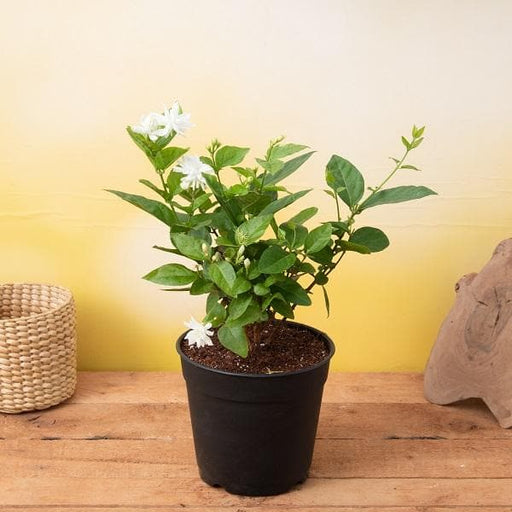
Ixora Dwarf (Red) - Plant
(MRP Inclusive of all taxes)
- Shipping ₹79 for entire order
- Dispatch in 7 days
- Country of origin: India

(MRP Inclusive of all taxes)
 Save 29%
Save 29%
Air Purifier Money Plant with Pot The Air Purifier Money Plant, also known as Pothos or Epipremnum aureum, is a stunning indoor plant that...
View full details
 Save up to 15%
Save up to 15%
Peace Lily, Spathiphyllum - Plant The Peace Lily, scientifically known as Spathiphyllum, is a stunning houseplant celebrated for its elegant white...
View full details
 Save 25%
Save 25%
Jasminum sambac, Mogra, Arabian Jasmine - Plant Jasminum sambac, commonly known as Mogra or Arabian Jasmine, is a fragrant flowering plant...
View full details
 Save 18%
Save 18%
Combo Constituents Includes the Parijat Tree (Night-Flowering Jasmine), a culturally significant plant with fragrant flowers. Description The Pari...
View full details
 Save 25%
Save 25%
Miniature Rose, Button Rose (Any Color) - Plant The Miniature Rose, also known as the Button Rose, is a charming and compact flowering plant that ...
View full details Save 25%
Save 25%
Damascus Rose, Scented Rose (Any Color) - Plant The Damascus Rose, also known as Rosa damascena, is a timeless symbol of beauty and romanc...
View full details
 Save 17%
Save 17%
Beautiful Fragrant Mogra, Arabian Jasmine Plant with Pot The Beautiful Fragrant Mogra, also known as Arabian Jasmine (Jasminum sambac), is...
View full details Save 15%
Save 15%
Pack of Vermicompost and Neem Cake for House Plants Transform your indoor garden with our premium Pack of Vermicompost and Neem Cake, spec...
View full details
Pack of Plant Growth and Flower Boosters Unlock the full potential of your garden with our Pack of Plant Growth and Flower Boosters! This ...
View full details Save 38%
Save 38%
Combo of Jeevamrut and Neem Raksha for Easy Growth and Protection of Houseplants Transform your indoor garden with our exclusive combo of ...
View full details Save 22%
Save 22%
Plant Nutrients Kit (Pack of 16) for a Healthy Garden Transform your garden into a lush paradise with our Plant Nutrients Kit, featuring 1...
View full details Save 16%
Save 16%
Combo of Top Plant Fertilizers Elevate your gardening game with our exclusive Combo of Top Plant Fertilizers, featuring two bags of premiu...
View full details Save 24%
Save 24%
Pack of 4 Additives to Make Soil Healthy and Nutrient Rich Transform your garden into a thriving ecosystem with our Pack of 4 Additives de...
View full details Save 30%
Save 30%
Transform your gardening experience with our premium Combo of Perlite and Vermiculite. This unique blend is designed to enhance soil aeration and ...
View full details Save 27%
Save 27%
Combo of 2 Vermicompost and Cocopeat - Enrich Your Soil Naturally! Transform your garden into a thriving ecosystem with our Combo of 2 Ver...
View full details
 Save 35%
Save 35%
Best 6 Plants for Perfect Indoor Garden Transform your living space into a lush oasis with our curated collection of the Best 6 Plants for a...
View full details
 Save up to 50%
Save up to 50%
Mini Succulent Garden Pack Transform your space with our Mini Succulent Garden Pack, featuring a delightful collection of 4 any variety beautiful s...
View full details
 Save 30%
Save 30%
5 Best Fragrant Plants Transform your garden or indoor space into a fragrant paradise with our curated selection of the 5 Best Fragrant Plants. Th...
View full details
 Save 24%
Save 24%
Set of 2 Bonsai Looking Grafted Adeniums Transform your indoor or outdoor space with our exquisite Set of 2 Bonsai Looking Grafted Adenium...
View full details Save 45%
Save 45%
Top 4 Die Hard Succulents Pack Transform your indoor or outdoor space with our Top 4 Die Hard Succulents Pack, featuring a curated selecti...
View full details
 Save 30%
Save 30%
5 Best Indoor Plants Pack Transform your living space into a lush oasis with our '5 Best Indoor Plants Pack.' This carefully curated collection fe...
View full details
 Save 25%
Save 25%
Set of 4 Evergreen Air Purifier Plant Pack Transform your indoor space into a lush, green oasis with our Set of 4 Evergreen Air Purifier Pla...
View full details| SrNo | Item Name | Qty |
|---|---|---|
| 2 | Ixora Dwarf (Red) Plant in 6 inch (15 cm) Pot | 1 |
The Ixora Dwarf (Red) is a stunning ornamental plant known for its vibrant clusters of red flowers that bloom year-round. This compact shrub, reaching heights of only 1-2 feet, is perfect for small gardens, borders, or container planting. Its glossy green leaves provide a lush backdrop, enhancing the beauty of its fiery blooms. Native to tropical regions, this hardy plant thrives in warm climates, making it a favorite among gardeners seeking a splash of color.
What sets the Ixora Dwarf (Red) apart is its ability to attract butterflies and hummingbirds, making it a delightful addition to any garden. Its resilience to drought and adaptability to various soil types make it a low-maintenance choice for both novice and experienced gardeners. Additionally, its vibrant red flowers symbolize passion and love, adding a meaningful touch to your landscape.
This plant is not only visually appealing but also environmentally friendly. Ixora Dwarf (Red) plays a role in supporting local ecosystems by providing nectar for pollinators. Its compact size makes it ideal for urban gardening, where space is limited, while its evergreen nature ensures year-round greenery.
The Ixora Dwarf (Red) contributes positively to the environment by supporting biodiversity. Its flowers provide essential nectar for bees, butterflies, and other pollinators, promoting a healthy ecosystem. Additionally, its ability to thrive in various soil types helps prevent soil erosion, making it a sustainable choice for gardeners.
If you think caring for plants is as easy as watering a cactus, think again! The Ixora Dwarf (Red) requires a bit of TLC. This little beauty thrives in well-drained soil and loves a good sunbath. Just remember, too much water can lead to root rot, and nobody wants that! So, channel your inner plant parent and give it just the right amount of love, and it will reward you with vibrant blooms that could make even a rose blush.
Patience is a virtue, especially when it comes to the Ixora Dwarf. This plant isn’t in a hurry to grow, but when it does, it’s like watching a slow-motion movie of a flower blooming. Typically, it reaches its full glory in a couple of years, so grab some popcorn and enjoy the show. Just remember, good things come to those who wait, and this little guy is worth every second!
Sunlight is the secret sauce for the Ixora Dwarf’s success. Think of it as the plant’s morning coffee—without it, it’s just not the same! This little gem loves bright, indirect light, so place it where it can soak up those rays without getting scorched. Too much direct sunlight can lead to crispy leaves, and nobody wants a plant that looks like it just came back from a desert vacation.
Fertilizing the Ixora Dwarf is like giving it a gourmet meal. A balanced, slow-release fertilizer during the growing season will keep it happy and blooming. Just don’t overdo it; too much fertilizer can lead to a plant that’s more “hangry” than happy. Think of it as a fine dining experience—quality over quantity is the name of the game!
Pruning the Ixora Dwarf is like giving it a stylish haircut. A little snip here and there can encourage bushier growth and more blooms. Just be sure to wield your shears with care; you don’t want to turn your plant into a topiary gone wrong! Regular pruning will keep it looking sharp and ready to impress anyone who strolls by.
Every plant has its enemies, and the Ixora Dwarf is no exception. Aphids and spider mites can be the uninvited guests at its garden party. But fear not! A little neem oil or insecticidal soap can send those pests packing. Think of it as a bouncer for your plant—keeping the riffraff out so your Ixora can shine in all its glory.
The right soil is like a cozy bed for your Ixora Dwarf. It prefers well-draining soil that’s rich in organic matter. Think of it as a five-star hotel for roots—no soggy bottoms allowed! A mix of potting soil and perlite will do the trick, ensuring your plant has the perfect environment to thrive and show off its fiery blooms.
Watering the Ixora Dwarf is a delicate dance. Too little, and it’ll be parched; too much, and it’ll drown. Aim for a watering schedule that allows the top inch of soil to dry out between drinks. It’s like a spa day for your plant—refreshing but not overwhelming. Keep an eye on the weather, and adjust accordingly; after all, even plants have their moods!
Pairing the Ixora Dwarf with the right companions can create a botanical dream team. Consider mixing it with other tropical plants that enjoy similar conditions, like hibiscus or ferns. It’s like hosting a garden party where everyone gets along! Just make sure they all have similar sunlight and watering needs, or you might end up with a plant drama that rivals reality TV.
The Ixora Dwarf is a showstopper in any landscape design. Its vibrant red blooms can add a pop of color to your garden, making it the life of the party. Use it as a border plant or in mixed beds for a stunning visual impact. Just remember, it’s not just about looks; consider its growth habits to ensure it fits perfectly into your garden’s aesthetic.
Want to multiply your Ixora Dwarf like rabbits? Propagation is the way to go! You can take cuttings and root them in water or soil, and before you know it, you’ll have a mini jungle of Ixoras. It’s like a plant cloning experiment, but way less complicated. Just be patient, and soon you’ll have a thriving family of these charming little plants to share with friends or keep all to yourself!
Ixora Dwarf (Red) is a compact, vibrant shrub that brings a splash of fiery color to your garden. With its glossy leaves and clusters of red flowers, it’s like a party for your eyes! Perfect for borders or containers, this plant is the life of the garden party, attracting butterflies and compliments alike.
Caring for Ixora Dwarf (Red) is as easy as pie—if pie were a low-maintenance plant! Provide well-drained soil, moderate watering, and a sunny spot. Fertilize every few months, and watch it thrive. Just remember, it’s not a fan of frost, so bring it inside if Jack Frost comes knocking!
Ixora Dwarf (Red) loves to bask in the sun like a beachgoer! Aim for at least 6 hours of bright, direct sunlight daily. Too little sun, and it might sulk, producing fewer flowers. So, give it the sunshine it craves, and it’ll reward you with a dazzling display of red blooms!
Watering Ixora Dwarf (Red) is like giving it a refreshing drink after a workout—just the right amount! Keep the soil consistently moist but not soggy. Water when the top inch feels dry, and avoid drowning it. Remember, it prefers a sip over a swim, so don’t go overboard!
Ixora Dwarf (Red) is a soil snob—it prefers well-draining, slightly acidic soil. Think of it as the Goldilocks of plants: not too sandy, not too clayey, but just right! A mix of potting soil and peat moss will make it feel right at home, ensuring it grows happily and healthily.
Absolutely! Ixora Dwarf (Red) is a pot-loving plant, thriving in containers like a champ. Just ensure the pot has drainage holes, and use quality potting mix. It’s perfect for patios or balconies, adding a pop of color wherever it goes. Just don’t forget to give it a sunny spot!
While no plant is completely deer-proof, Ixora Dwarf (Red) is not on the top of their menu. Its slightly bitter taste and dense foliage make it less appealing to these four-legged diners. So, plant it with confidence, and let the deer munch on your neighbor’s garden instead!
Ixora Dwarf (Red) is like a garden diva, blooming from spring to fall. It flaunts its vibrant red flowers in clusters, attracting pollinators and envious glances. With the right care, it’ll keep the floral show going for months, ensuring your garden is the talk of the town!
Pruning Ixora Dwarf (Red) is like giving it a stylish haircut—just the right trim! Do this in late winter or early spring to encourage bushy growth and more blooms. Snip away any dead or leggy branches, and shape it to your liking. Your plant will thank you with a fresh, fabulous look!
Ixora Dwarf (Red) prefers a drink but can handle short droughts like a seasoned pro. Once established, it can survive brief dry spells, but don’t push its limits! Regular watering is key to keeping it vibrant and blooming. Think of it as a plant that enjoys a good spa day—hydration is essential!
Ixora Dwarf (Red) can attract a few uninvited guests, like aphids and spider mites. Keep an eye out for these pesky critters, and act fast if you spot them. A gentle spray of insecticidal soap or neem oil will send them packing. Your plant deserves a pest-free life, after all!
Absolutely! Ixora Dwarf (Red) is like the friendly neighbor who helps you with your gardening woes. It’s low-maintenance, forgiving, and rewards you with stunning blooms. Perfect for beginners, it’s a great way to dip your toes into the gardening world without feeling overwhelmed. Get ready to impress with minimal effort!